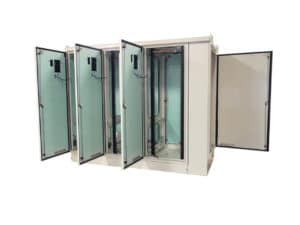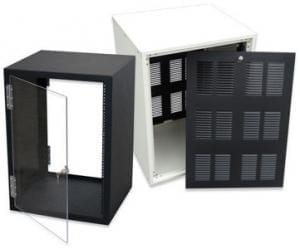3 Key Differences Between Indoor & Outdoor Telecom Enclosures
When telecommunications and networking companies choose an enclosure, they know whether that cabinet will be outside or inside.
What makes an outside cabinet properly suited for the outdoors, and what makes an indoor cabinet suited for inside applications?
There are actually huge differences between indoor and outdoor telecom enclosures. For this article, we’re going to break the differences down into three major categories–NEMA rating, construction/design, available accessories and overall functionality.
Read on to see why indoor cabinets aren’t ideal for outdoor environments, and why it’s not worth spending the extra money on an outdoor cabinet if your application will be indoors.


Indoor vs. Outdoor Telecom Enclosures
NEMA Rating
The National Electrical Manufacturer Association (NEMA) provides a rating system for electrical enclosures used in industrial applications. The ratings, which range from 1 to 13, denote what hazards an enclosure protects against.
Indoor enclosures generally carry a NEMA Type 1, 2, 12 or 13 rating. They provide a degree of protection against ingress by falling dirt/dust, dripping or light splashing liquids, circulating flyings and more, depending on the rating. These ratings are a result of indoor enclosures being vented and not having gaskets on openings, unlike outdoor enclosures.
Outdoor enclosures carry a NEMA Type 3, 4, 5 or 6 rating (7–11 ratings apply to hazardous conditions/material enclosures and generally do not apply in the telecom or networking industry). These ratings also have modifiers that indicate more or less protection. For example, 4R omits protection against windblown dust, but 4X indicates additional corrosion protection, which is necessary for enclosures being used near bodies of saltwater and other caustic or acidic environments.
Click here to learn more about enclosure ratings.
Welding, gaskets, powdercoating and more contribute to an enclosure’s NEMA rating.
Yes, you can use an outdoor-rated enclosure inside, but outdoor enclosures feature bulked-up protections that make them more expensive. To ensure you’re not spending money on protections your enclosure doesn’t need, look at where your enclosure will reside and then look at the ratings to determine what level of protection your enclosure needs.
Construction & Design
Indoor enclosures don’t need as much protection, therefore they don’t need to be constructed as rugged.
That’s not saying indoor enclosures aren’t quality built. They just don’t have to stand up to the hazards found in the outdoors, e.g., hailstorms, heavy rain, wind and falling objects. They’re a lighter duty design and often not subject to as much deflection testing.
Indoor cabinets can be made of thinner-gauge materials, and possibly even materials like stainless steel. While steel is a quality metal with plenty of longevity, it’s not as corrosion resistant as aluminum or galvanized steel, and therefore more ideal for inside applications. Indoor cabinets are also sometimes made of heavy-duty plastics.
Secondly, indoor enclosures are usually in a secure environment, so they themselves do not need as many, if any at all, added security measures. Outdoor enclosures are often in unprotected, unmonitored areas, and therefore need extra security measures to keep their contents safe from vandals. Some of those measures include locking doors and alarms.
Basically, enclosures are built to meet the needs of the environment they’ll reside in, and that results in different levels of ruggedness and security.
Accessories
Just as environment dictates the NEMA rating and design, it will determine what additional accessories are needed to protect the equipment inside. And as with the NEMA rating and overall design, it will vary greatly between indoor and outdoor cabinets.
In general, indoor cabinets don’t require a lot of add-ons to meet the organization’s needs.
Outdoor cabinet, though, are available with a wide variety of optional accessories. Some common ones we install at American Products include:
- Grounding systems
- Climate control systems & insulation
- Aggregate shelter exterior
- Surge protection
- Door alarms
Many of the same accessories can be added to indoor cabinets, but it’s usually not necessary and therefore rather rare.
Whether you need an indoor cabinet for terminating a fiber run or a series of outdoor enclosures or shelters to expand your network, we can help. At American Products, we specialize in designing and producing integrated enclosure solutions to meet virtually any telecommunications and networking organization’s needs.
And rest assured that our team will work closely with you determine exactly which enclosure and accessories will fit the cabinet’s environment to a Tee.
Contact our enclosure specialists at 417.323.6312 to learn more and start building your new integrated enclosure solution.
P.S. Check out our blog post 7 Ways to Protect Your Telecom Enclosures!
All content on this Site, including but not limited to text, graphics, logos, icons, images, audio, designs and video, is the property American Products and its affiliated companies and is protected by United States and international copyright laws. Use without express permission is strictly prohibited.
